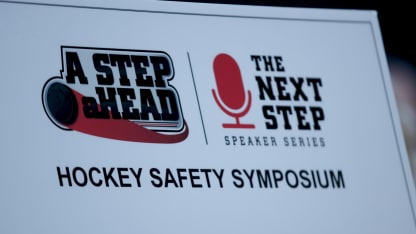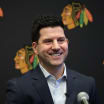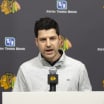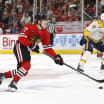The physical, emotional and social well-being of young athletes represented the major points of emphasis delivered by six prominent local and national experts during the Hockey Safety Symposium held Sept. 29, in the United Center Atrium.
The free event, that was part of the "A Next Step Speakers Series," attracted youth hockey coaches, mentors, parents, and other interested parties. They were among an engaged audience during the 5-hour presentation set up by the Blackhawks staff.
FEATURE: Step aHead educates the community
The Hockey Safety Symposium that was held in September at the United Center helps educate the Illinois youth hockey community on the importance of safety in sports

By
Fred Mitchell / Community Correspondent
@ Dr. George Chiampas, who addressed emergency preparedness:
"A non-contact collapse by an athlete is an emergency," said Chiampas, who is an assistant professor in the Departments of Emergency Medicine and Orthopedics at the Feinberg School of Medicine at Northwestern University and Northwestern Memorial Hospital. "It could be heat stroke, seizure, low salt level or heart-related."
Dr. Chiampas, who is a team physician for the Blackhawks, showed alarming video clips of athletes in various sports in severe physical distress. His message was that emergency preparedness is paramount when an athlete collapses for whatever reason.
"You are the bridge to their safety," he said. "You have been trained in CPR. Learn how to use a tourniquet…have a plan for emergencies. Build a culture of safety."
Dr. Chiampas emphasized the importance of having an AED (automated external defibrillator) available within reasonable sight and access during athletic practices and games.
@ Dr. Meeta Singh, a board-certified sleep medicine specialist, addressed the impact of proper sleep on an athlete's performance and overall well-being.
"Poor sleep does affect athletic performance," she said. "More sleep means athletes are less likely to get injured. And you need sleep to get optimal reaction time."
Speaking to youth hockey coaches and parents, Dr. Singh added: "Young athletes need about nine hours of sleep. Parts of the brain get less blood when you get less sleep. And deep sleep is key for muscle restoration."
Dr. Singh has served as a consultant for several NFL, MLB, NHL and NBA teams, as well as college teams.
"Most student/athletes are sleep-deprived," she said.
@ Tavis Piattoly from the Taylor-Hooton Foundation, warned attendees of the dangers of illegal steroids.
Taylor Hooton was the young athlete from Plano, Texas, who was advised in high school to gain some weight in order to become more likely to receive a Division 1 athletic scholarship. He asked his friends and teammates how they were able to put on muscle and weight and was advised to turn to steroids. The once cooperative and conscientious Hooton soon became belligerent and combative. When he finally confessed to taking the anabolic steroids, Hooton took his own life by hanging himself in his bedroom on July 15, 2003, at the age of 17.
Piattoly alerted attendees that 18-25 percent of supplements are spiked with steroids. And he added that the highest-growing group of steroid abuser is females around 15-16 years old, who mainly take them to improve their appearance.
Piattoly said there are estimates that two million high school and middle school students are using steroids, in large part because of role models, media images and body image.
@ Joe Terrasi, the lead trainer for the Chicago Chapter of the Positive Coaching Alliance, spoke passionately about the importance of building a supportive team culture that discourages bullying and hazing.
"Inclusion is an important concern of mine," Terrasi said. He added: "Social media is a perfect venue for someone who wants to mistreat a child."
Terrasi believes coaches should abandon the stereotype role of a yelling, demanding and often demeaning their players.
"A caring climate leads to winning," he insisted. "Stress goes up with negative talk. Make a connection with every athlete."
Terrasi is a former athletic director at Gordon Tech High School. He continues to coach basketball in high school and youth programs and is the parent of a high school ice hockey player.
"A lot of times we don't to play for the moment," Terrasi said, regarding the pressure placed on young athletes to perform well enough to make it to the next level of competition. "I am also very concerned about the kids with special needs."
@ Paul Goodman, the strength and conditioning coach for the Blackhawks, addressed the importance of trying to prevent injuries through proper conditioning.
"Preventing the preventable is what I call it," Goodman said. "You can't go to the top solely on playing. I can train any athlete regardless of the sport. There has to be a collaboration if an athlete wants to get better."
Goodman also is the owner and head performance coach of RiSE Performance Institute.
"Prepare, perform and perpetuate. It has to be a rinse-and-repeat mentality," Goodman said.
@ Dr. Elizabeth Pieroth, a board certified clinical neuropsychologist, addressed the topic of concussions in all sports, including hockey. She described a concussion as: "Any blow to the head that causes mental status to change, disorientation, confusion, memory loss or slowness in thinking."
As the associate director of the NorthShore University HealthSystem Sports Concussion program, Dr. Pieroth said: "We need to prioritize safety."
Wrestling, men's hockey, women's hockey and football incur the majority of concussions.
"Lots of elbows to the head," she said.
Dr. Pieroth has been involved with the assessment of NHL players since 1997 and is the Head Injury/Concussion specialist for the Bears, Blackhawks, White Sox, Fire and the National Women's Soccer League.
"The A Step aHead program was formed more than eight years ago with a goal of educating players, parents, coaches, and officials about the dangers of concussion in hockey," said Pieroth. "Unfortunately, there are other health and safety issues that are relevant to youth hockey players. We wanted this symposium to offer an opportunity to learn from experts about these issues, such as sudden cardiac arrest, prevention of skeletal-muscular injury, and the use of steroids/performance enhancing drugs. We also know that other topics, such as sleep and athletic performance or bullying in sports, are also very important to the physical and emotional well-being of our youth athletes. We hope that the information provided at this symposium helps address the multiple aspects of health and safety for kids, and it really is all due to the generosity of the Chicago Blackhawks and the amazing work by all of the A Step ahead crew."


















